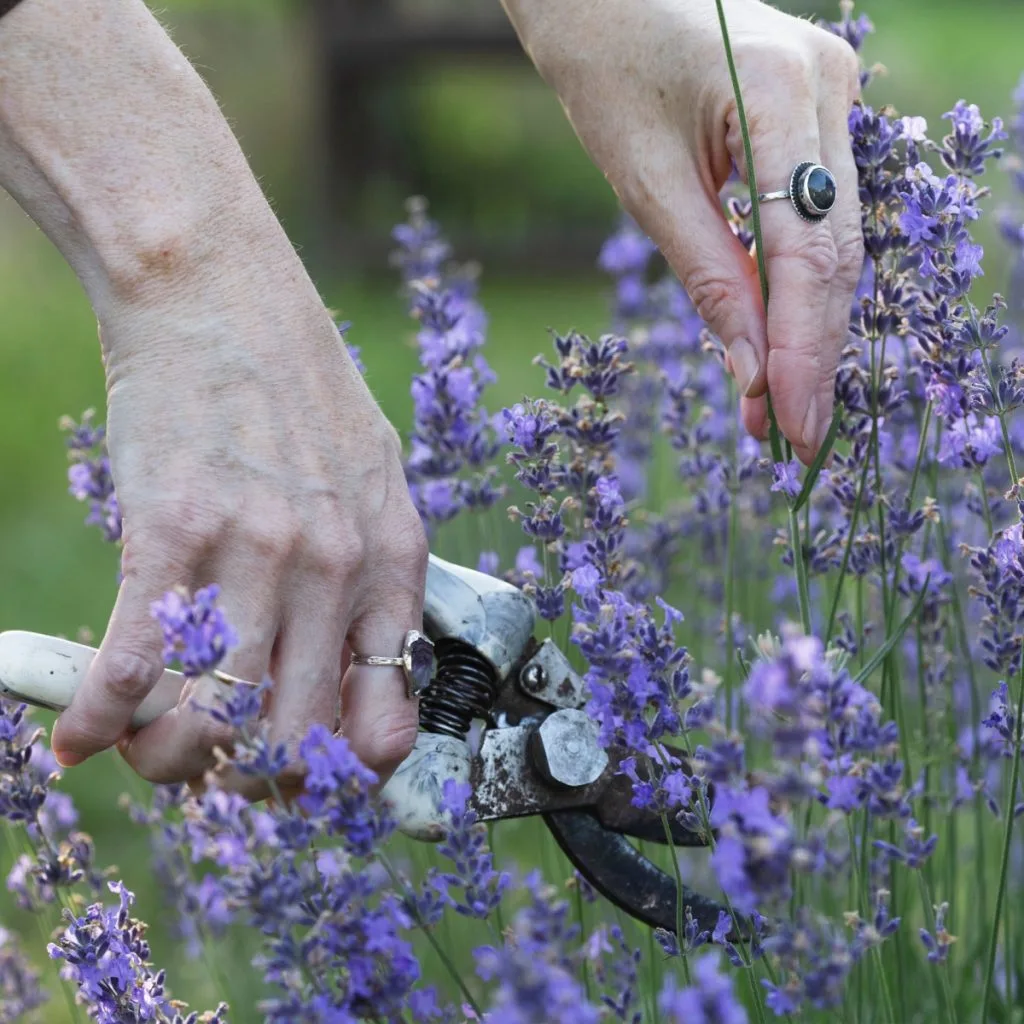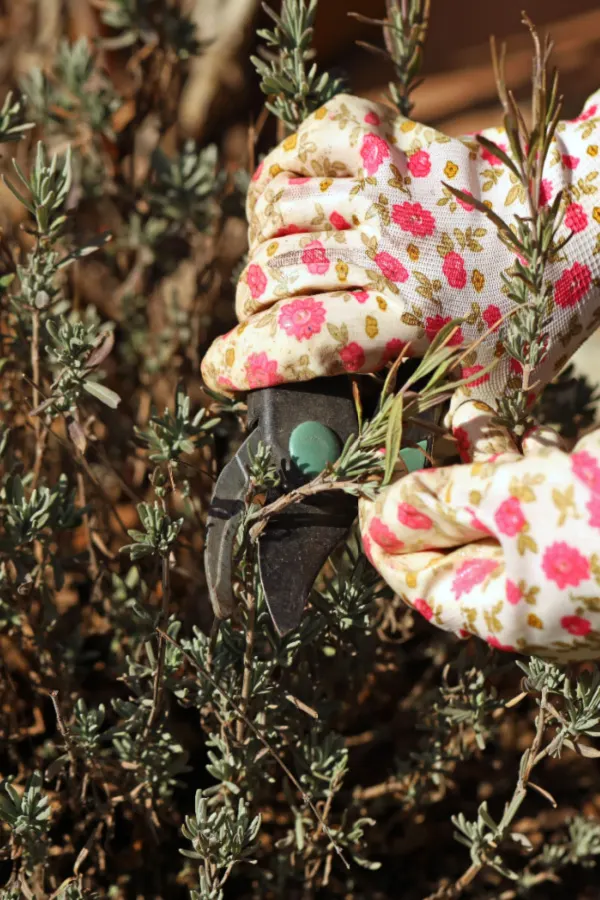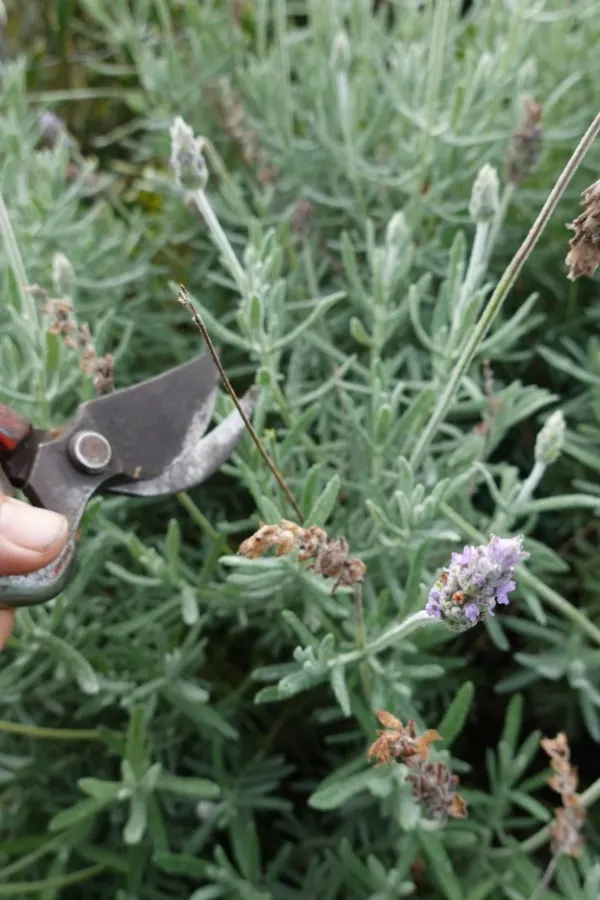Wondering if you need to prune back your lavender this summer to help it stay healthy and strong – and maybe even bloom again this year? The answer is yes!
With its silvery-green foliage and purple flower spikes, lavender not only looks stunning, but also attracts bees, butterflies, and even hummingbirds. And as an added bonus, the scent of lavender is not only pleasant – it can also help keep pests like mosquitoes away.
But if you want your lavender to stay looking good all summer long – and for years to come – it needs a bit of help once it finishes its first big bloom. And that help comes in the form of summer pruning.

Pruning lavender at the right time during the summer can keep it from becoming woody, leggy, and unattractive. But even more, it can help promote a second round of flowers later in the season.
How To Prune Back Lavender In The Summer
Why Cutting Back Is So Important
Many gardeners are afraid to cut back their lavender plants in the summer. Especially right after they bloom. It’s understandable, after all, no one wants to risk damaging a plant that just looked so beautiful. But skipping this important pruning step can actually shorten the life of the plant. It can also make it much harder to manage as time goes on.
Lavender is a woody perennial, meaning it grows from the same roots each year, but the base of the plant becomes more woody and stiff over time. If you don’t prune it back regularly, that woody growth begins to take over the plant.
Soon, the lavender loses its nice rounded shape and becomes stretched out, thin, and top-heavy. Once that happens, it’s hard to reverse. And in many cases, the plant may stop blooming well altogether.
Pruning helps in a few other important ways as well. First, it encourages fresh new green growth instead of old, tough woody stems. Second, it helps the plant keep a nice mounded shape instead of sprawling out. Third, it allows better air flow through the plant, which reduces the chance of mildew or other fungal diseases.

Finally, if done at the right time, it can trigger the plant to bloom again. Not next year – but later in the same summer or early fall!
When To Prune Lavender In The Summer
The best time to cut back lavender in the summer is right after it finishes its first big bloom. For most varieties, this happens sometime between late June and early July, depending on your location and weather.
You’ll know it’s time when the vibrant purple blooms begin to fade and dry out. At this point, the flowers are starting to go to seed, and the plant will naturally begin to slow down its blooming.
If you cut the spent flowers off before the plant puts too much energy into forming seed heads, you give it a signal to keep growing instead of shutting down. This is the best window to prune to allow it to rebloom!
Don’t wait too long after the flowers fade, though. If you allow the plant to sit with old blooms for weeks, it may not respond with a second flush. The sooner you prune once the blooms are spent, the better your chances of seeing more flowers later in the summer.

How To Deadhead Lavender And Prune It Back
Deadheading lavender is the first part of the pruning process. This means removing the spent flower stalks. To do this, take a pair of sharp pruning shears or garden scissors and snip the flower stems back down into the green foliage. Affiliate Link: Gonicc 8″ Professional Premium Titanium Bypass Pruning Shears
Never cut back into the woody base when deadheading. Look for where the green growth starts and cut just above a leaf node. This is where two small leaves meet the stem. Cutting above this point will encourage new branches and shoots to form, which can develop into new flower spikes.
Once you’ve removed all of the spent blooms, you can go a step further and give the entire plant a light trim. This is especially important if the lavender is starting to look stretched out or uneven. Use your shears to lightly shape the plant into a round mound.
Again, be sure not to cut into any brown, woody stems. Lavender does not regenerate well from old wood. Only trim green, soft growth. A good rule of thumb is to remove no more than one-third of the plant’s size during summer pruning. This keeps the plant healthy and encourages fresh, compact growth.
What To Do And Not Do After You Prune Back Lavender In The Summer
Once you finish pruning, you may notice your lavender looking a bit smaller or less full. Don’t worry, this is exactly what you want. Within a week or two, new growth will begin to appear where you made your cuts. In just another few weeks, many lavender varieties will start to produce another round of purple blooms.

Keep in mind that not all lavender types rebloom after a summer pruning. This is especially true in cooler climates. But even if your plant doesn’t flower again, the pruning will still help it stay strong and full for next year.
Avoid Fertilizing Lavender
One of the biggest mistakes gardeners make after pruning lavender is trying to “help” it by feeding it with fertilizer. But lavender doesn’t like rich soil or strong fertilizers. In fact, fertilizing lavender -especially in the summer – can do more harm than good.
Lavender naturally grows in poor, rocky soils with very little nutrients. When you feed it with fertilizer, especially one high in nitrogen, it can cause the plant to grow too fast and become soft and leggy. This soft growth is more likely to flop over, and it usually comes at the expense of flowers.
Instead of blooming, a heavily fertilized lavender plant may put out lots of green foliage and very few flowers. Even worse, too much fertilizer can stress the plant and shorten its life. After pruning, just let your lavender recover naturally.
If you’ve planted it in a sunny spot with well-draining soil, it will bounce back just fine on its own.
Watering Lavender After Pruning – Less Is More
Just like with fertilizing, it’s important not to overdo it when watering lavender after you prune it back in the summer. Lavender is drought-tolerant once established, and it actually prefers dry conditions over wet ones.

After pruning, some gardeners assume the plant needs extra water to recover. But too much moisture can lead to root rot and other issues. Lavender does not like wet feet, and sitting in soggy soil is one of the quickest ways to kill the plant.
The best approach is to water only when the soil around the base is completely dry. Stick your finger about an inch or two into the ground. If it feels moist, wait a few more days before watering. If it’s dry, give it a deep watering at the base of the plant. This is where an inexpensive moisture meter can be an invaluable tool! Affiliate Link: XLUX Long Probe Deep Use Soil Moisture Meter
Never water from overhead. Instead, aim for the roots and avoid splashing water on the foliage. Wet leaves in the summer heat can invite mold and mildew. A light mulch of small gravel or stone around the base can help keep weeds down while allowing water to drain freely.
One thing is for sure, taking a little time to prune back your lavender in the summer can keep your lavender plants full, vibrant, and healthy for years! For late season lavender care, check out our article: What To Do With Lavender Plants In The Fall – And What Not To!
Simple Garden Life
Follow Our Facebook Page For Even More Great Tips! Simple Garden Life Facebook Page
Simple Garden Life is a website dedicated to keeping gardening fun, simple and enjoyable! We publish two new articles each week along with a new garden podcast episode every two weeks. This article may contain affiliate links.
